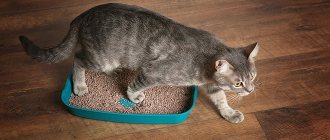What will you learn from the article?
- Cat training - list of commands
- Training cats at home - basic principles Contact me
- Bring it
- Sit
- Lie
- Stand
- Kiss
- Give me your paw
- Jumping through a hoop
- Stand on your hind legs
Dogs are trained in a huge number of kennels and special schools; cats are less fortunate - they are mostly trained at home. Let's look at the basic principles of cat training and the most common commands that you can teach your pet yourself at home.
You can train a kitten when it is 7-8 months old. It is at this age that the animal has matured enough to adequately perceive the owner’s instructions and try to follow them.
Cat training is an activity that requires patience on the part of the cat owner. Before you start training, you need to carefully observe the cat and study all its habits, favorite activities and games, and character traits. Such observation will help you competently create a training program, organize training in stages and get the most out of your pet.
Is it possible to train a cat
Mustachioed sneaks with a cunning look and hunting habits are not dogs devoted to their master and ready to obey. No offense will be said to the barking brothers. The small predator has a natural desire to dominate. A representative of the cat tribe cannot be forced, but she can be persuaded. Then she will fulfill the person’s request. Attachment to the owner is a vulnerable character trait of a proud animal, which allows him to instill unusual skills.
Video: pet turns off the light
The debate about whether cats can be trained has been going on for a long time. There is no consensus on this matter among owners, breeders and felinologists. It cannot be any other way: everyone makes their own arguments based on personal experience. For example, one argues that animals are not teachable. And he motivates with the story that he was unable to develop a conditioned reflex in his pet to the “Voice” command. The owner said this word for half an hour, showing the tasty “prize” to the adult Briton, and he looked at the man’s efforts with bewilderment. Even repeating the order along with “meow” turned out to be useless. Defenders of cat abilities say: pets feel a person so much that they guess the command even before it sounds. They are just pretending, playing at submission. Or they try to please in the hope of getting something tasty. And the owner is happy that the necessary action has been completed, and considers himself a tamer. The third judgment is also based on the example of the behavior of an already trained cat. Knowing exactly the meaning of the order, she refuses to carry it out. Not out of forgetfulness, but on purpose. We have to conclude that standard training with unquestioning execution of a person’s command is impossible. When the opportunity arises, your pet will always show a headstrong character.
Basics of education
The optimal age to start training, as we have already said, is six months. Since it is at this time that it is easier for the pet to master commands. The basics of education, along with the breed, play a fundamental role in training. Strict adherence to behavioral norms and sincere relationships between owner and pet are also a priority. It is advisable to begin preparations by accustoming the kitten to the rules established in the home.
The most important rules for starting successful training:
- It is necessary to buy the pet its own toys, otherwise for active entertainment the kitten will play with the things of the owner and his family.
- For sleep and rest, a young cat needs to have its own place. She should not play or doze on the master's beds and sofas.
- Just like a child, you should never yell at kittens or, especially, hit them. A stern and slightly raised voice will be enough for them to understand that they are being punished. Animals are good at distinguishing human intonation and remembering what they are not allowed to do.
- From the first months, the kitten must know the location of its plate. You cannot throw food from the table, otherwise he will jump on it and steal food.
- The cat must know that the litter tray is in the same place and needs to go only there. The first time he needs to be placed in the tray and not allowed to leave for 2-3 minutes.
- The psychology of communication is very important. You need to establish a trusting relationship with your domestic cat so that training does not cause problems in the future. It is worth paying more attention to the kittens, playing with them, stroking them and trying to reward them for following orders and good behavior.
When to start training
A four-month-old kitten already responds to its name when you feed it or call it. At six months of age, the baby begins to play and run for a long time. He is curious, knows no fear and trusts those around him. Without wasting time, the owner should take a closer look at the ward, his habits and favorite toys. Observations will help you create a plan for future training. This is how they work in circuses.
The carefree toy begins to be taught simple commands, which do not require physical effort, in their “teenage” years. At 7–8 months the animal is ready for dialogue with humans. To show his affection, the furry parodist will try to fulfill the owner's demands.
Summarizing
Training a cat is a very exciting process, and most importantly, it quickly bears fruit. Already after the first day of training, the owner can enjoy the results of his work - the cat will follow commands. The main principles of successful training are patience, affection and perseverance, as well as repeated repetition and positive motivation of the pet.
The main thing is not to deceive the cat, always reward it after executing a command, using one selected word (for example, “Bravo” or “Excellent”), which is not used in everyday life. End the training with praise and play with your pet so that he understands that learning is pleasant and beneficial.
Rules for working with animals
They train in a quiet room, staying alone with the pet. Lesson duration is 10 minutes with a rest break. Each action is practiced 4–5 times. A program to introduce your furry pet to new skills doesn't have to be stressful. You cannot engage in training after vaccination, as well as in case of any painful conditions. Do not learn two tricks at once, so as not to confuse the animal. Remember that training abilities vary.
Tip: train your pet during the day or evening, 3-4 hours after feeding. A hungry animal will not want to work, but a well-fed animal will prefer to wash itself and take a nap.
What you will need
Instead of a spacious circus arena, any flat area that is convenient for you and your cat will do: a floor with a rug or a grassy lawn near the house. For more complex tricks, you will have to prepare special furniture. Select toys: a tennis ball or a skein of woolen thread.
Training equipment:
- chairs or round tables;
- small balls;
- hoop with a diameter of 35 cm;
- laser pointer;
- closed container for food.
Vitamins, pieces of meat or hard cheese are used as rewards. They should be small, 3–4 mm in size. If the portions are larger, your pet will quickly lose interest in work. Dry food is not suitable - the cat will not be able to swallow it right away and will chew it, distracted from the lesson.
Owner's behavior during training
Commands are pronounced in a calm, convincing voice. They help the mustachioed pet with gestures. For example, lightly slam your palm on the floor while teaching the “Lie Down” command. The main condition for successful interaction with an animal is the absence of the slightest punishment. Otherwise, further classes will be impossible. The treat is not given if the element is performed incorrectly. Explain again what needs to be done. Noticing that the animal is not in the mood or is too passive, work on the trick is stopped.
How to teach a cat to give paw
“Give me your paw” is a simple command, every tailed animal can learn it. It looks cute and impressive. Teaching a cat to give paw is easy. You need to approach a sitting animal, put its paw in your hands and say, “Give me your paw.” When the ritual is over, you need to reward the kitten for a successfully completed command by treating it with a treat.
A reflex should be formed in the experimental subject’s brain, which should provoke the kitten to give its paw, based on pleasant memories.
If the cat independently reaches for a treat lying in the palm of your hand, then it is not necessary to take the cat’s paw in your hand. It is enough to say the name of the team when your pet tries to take the reward.
If the cat does not want to give his paw and is constantly distracted by more interesting things, it is better to postpone training and prepare him for training, based on the first point of the article.
Basic commands for cats
Start teaching your home artist with simple instructions. First master: “Come to me,” then “Sit” or “Give me your paw.” Walking like a snake also does not require much physical effort. When your mustachioed friend can stand for at least 5 seconds without leaning on anything, start jumping exercises.
Sit
Hide a couple of pieces of food in your fist. Cross your arms over your chest, letting your cat know you have a treat in store. Wait until she sits next to you, taking the pose of an Egyptian sphinx. Then immediately say the command and reward with a treat. Then raise your palm above her head and force her to stand. Repeat the exercise two or three times, ensuring that the pet sits at your command for 5-6 seconds and reinforce obedience with a piece of food and praise.
Lie
The easiest way to teach a furry fidget this trick is when he is tired of playing and wants to rest. Stroke the cat on the back so that it assumes a horizontal position. Name the team, don’t forget to give them a piece of food. Unfortunately, this method is used only on occasion and is not suitable for daily practice.
Learning the command “Lie down” begins after following the orders “Come to me” and “Sit”
With the usual method of training, a sitting pet is lured with food, lowering the piece almost to the floor. Of course, first the animal will try to catch a portion of food with its claws. The owner, without wasting time, must push the front paws so that the cat sits on its stomach. All that remains is to say: “Lie down!” We give the pet a tasty reward in such a way that he takes it without getting up. Otherwise, the animal will get confused and will not be able to understand what needs to be done.
Stand
The trick is taught on a chair with a backrest so that the animal, especially a young one, is not afraid of losing its balance and falling. Show the cat a piece of food, holding it in the fingers of your right hand. They turn away and quickly transfer the treat to their left palm. The free one makes a conditional gesture over the pet's head, forcing it to stretch up and stand on its hind legs. She will try to grab your hand with her front ones. Order: “Stop!” After two seconds, give the prepared piece of food, praise and caress.
Give me your paw
The command is executed when your furry pet sits next to you. Hide a treat in your clenched fingers. Let her sniff the fist and try to get the food. Press the raised paw into the palm of your free hand, give the order and reward the “student”.
A piece of treat in the pet's field of view makes the training process easier
In some cases, the trainer himself has to take hold of the clawed metacarpus, showing the cat what action is required of it. The forced method of explanation is used if the animal tries to get food with its teeth.
Video: how to teach a cat to say hello
Usually the pet easily learns the command and demonstrates a new skill within a week.
To me
To practice the skill, choose a moment when your mustachioed friend is at a distance but sees you. Show the prepared reward, say the name of the pet with the addition of the command “Come to me.” If you run up right away, please them with something tasty and say: “Good” or “Bravo”. Distract the purr with something and repeat the order 2-3 times, no more.
Bring it
While frolicking, kittens often drag their favorite toys around the house. Having matured, animals retain this habit. The trainer can only improve it. It is enough to pick up a ball of thread from its mouth and throw it at a distance of no more than a meter. If your pet grabs a rolling ball and moves away, follow it. Saying: “Bring it,” remove the object from the animal’s mouth and treat it with food.
The difficulty of this task is that the fast runner should not place the toy on the floor near the trainer’s feet. He needs to return with the item and give it to the owner. To get the desired result, you will need patience.
Jumping through a hoop
To prepare the trick, decorate a plastic or cardboard circle with bright fabric. The device should be familiar to the cat and not cause fear in it. Place the hoop in front of the future circus performer, holding it with your right hand. Use your left hand with a piece of cheese to lure your pet to step over the obstacle. Having said: “Up”, hand over the treat.
When the animal can freely walk back and forth inside the device, raise the ring 5–7 cm. Reward your pet every time after a jump. Gradually increase the height of the hoop above the mat until it reaches half a meter.
To teach tricks, choose a secluded place so that the pet is not distracted by anything.
Kiss
The trick is intended for affectionate animals who love to express their sympathy for humans. Before training, lubricate the tip of your nose with pate. Sit back and call the cat. Let him jump into your lap. Take the purring purr in your arms and stroke it. Then tilt your head towards his muzzle so that your noses touch. When your furry pet starts licking the “bait”, say: “Kiss” and do not skimp on words of approval.
The “Kiss” command is taught to vaccinated animals that do not have access to the street.
Somersault
Rolling from one side to the other is a natural ability of the cat tribe. This is an invitation to play and a desire to share a great mood. A person can only complicate the task by getting a circus act. After the “Lie down” command, bring the food hidden in your fingers to your pet’s face. Slowly move your hand behind the withers, then along the back to the tail. Wanting not to lose sight of the treat, the cat will roll over, stretching its front paws. Lightly tap your palm on the floor so that the purr is back on his stomach. Give the command: “Somersault” and reward for execution.
Snake
Walking a trained cat between its handler's legs is an age-old trick. He always makes the audience smile. To teach your animal this skill, choose a moment when your pet is nearby and step forward. To make the learning process easier, take the food supply in both hands. Lure with a treat by moving your palm to the side of your knee. When the pupil goes around the leg, move on and continue the lesson, repeating the word: “Snake” or “Snake” and periodically rewarding with food.
Tricks
If the decision to train a cat has been made, you need to be patient. It is necessary to take into account the waywardness of pets.
Bounce
- Place the animal on a chair.
- Place another one nearby and place a piece of food on it.
- When the cat makes a jump, you need to pronounce a short and concise decree, for example “Up”.
- After landing, don’t forget to praise the stuntman.
When the cat learns to react quickly, you can try giving food from your hands, repeating the commands step by step. The transition to the next tricks is possible only when the animal learns to instantly carry out the order. Frequent rehearsals are needed to consolidate the material.
Sit
The “sit” command is useful for restraining a cat, for example, during medical examinations. With regular encouragement of sitting still, the pet will learn to wait for food without getting in the way. How to teach:
- Show the animal a piece of treat and entice him to come to you.
- After the cat has approached, raise your hand slightly above his head.
- Repeat the trick on a regular basis, remembering to say the command. It will be short and catchy - “sit down.”
We must remember that cats should not feel pressure. They are too proud to follow human orders, so the command must be pronounced calmly and confidently without raising the tone.
Bring it
Entertainment team. You can demand to move objects in your teeth by initially throwing this same toy. Cats love foil, so you can start training with a shiny piece rolled into a ball.
- You can play with your cat with a small and light toy.
- Throw her nearby.
- When the animal takes the toy in its teeth, say the command.
- Don't forget to praise the cat and reward it with a treat.
- When she wants to eat, she will bring the toy to her feet.
Yuri Kuklachev with his cat
Lie
This command is an indispensable skill when visiting the veterinarian. The cat needs to be seated, shown a tasty morsel and slowly lowered down. Of course, the animal’s head will fall behind it, then you need to move the food to the side. Ideally, the pet should lie down on its own. As soon as the cat lies down, you can praise him and treat him with food.
Overcoming obstacles
For those cats that like to constantly jump from place to place and look for higher places, you can try a complex with obstacles. To start training, you can get by with two regular chairs. The cat is seated on one of the chairs, and a treat is placed on the second, and it will make a jump on its own.
To obtain the correct and quick result, cat chairs should be placed at a minimum distance . The cat must learn that there is always a treat waiting for it on the opposite side. Then the chairs are moved further away. When it is maximum, you can include a hoop in the set of obstacles for the cat.
Training and education
The terms “training” and “education” mean the process of developing certain reactions and behavioral skills in a cat, however, there are fundamental differences between them. Training is a systematic influence on a cat in order to develop certain skills in it. Through repeated repetitions, reinforced with encouragement, the pet is taught to follow commands.
Education is a broader concept; its goal is to instill rules of behavior in the cat. This is an integral aspect of pet ownership, as wayward animals sometimes do things that their owners consider unacceptable. This process begins from the moment the cat appears in the house and does not end throughout its life. Unlike training, education is not about teaching an animal to follow commands, but about developing an understanding of what is bad and what is good.
Use a reward system
Rewards for good behavior are a great incentive, especially during training. There are two types of rewards for your furry friend that you can try out. First, know that your cat will appreciate any praise you give. Speak in a kind, cheerful voice and remind your cat that you are proud of her. Say, “What a nice kitty,” and “Well done!” while stroking her fur, so she understands that these gestures mean that she did everything right.
Cats also love treats. If suddenly your pet does what you wanted from her, give her some Science Plan food. To do this, you can use the clicker system. When your cat completes the command correctly, turn on the clicking tool and then give him a treat to signal that the command has been completed correctly. If your cat hears such a click every time it performs an action correctly, it will learn to perform well what you teach it.
I teach at home by playing
How do I teach? The kitten is growing quickly - before you have time to blink an eye, you look, and already he is eating on his own, going to the litter box, jumping and climbing on everything that his claws cling to, and running happily when called. All the furry's affairs are a game!
The naughty boy himself learns as he grows to accurately jump from a stool to a cabinet, jumps over obstacles, carries small paper balls in his teeth, and my task is to consolidate new, interesting skills, formulate them into a trick, and come up with commands.











